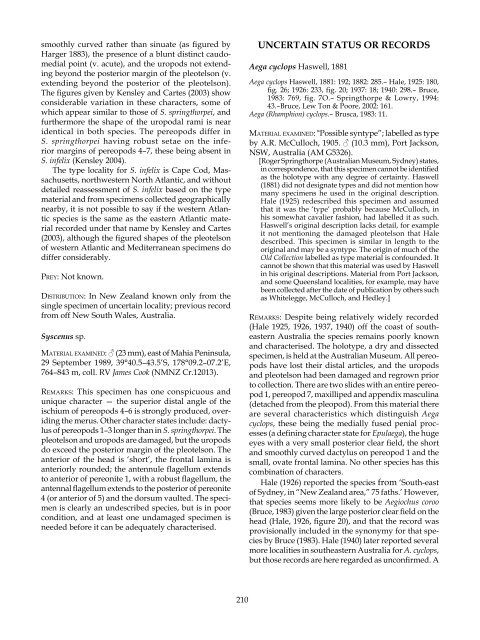The Marine Fauna of New Zealand: Isopoda, Aegidae (Crustacea)
The Marine Fauna of New Zealand: Isopoda, Aegidae (Crustacea)
The Marine Fauna of New Zealand: Isopoda, Aegidae (Crustacea)
Create successful ePaper yourself
Turn your PDF publications into a flip-book with our unique Google optimized e-Paper software.
smoothly curved rather than sinuate (as figured by<br />
Harger 883), the presence <strong>of</strong> a blunt distinct caudomedial<br />
point (v. acute), and the uropods not extending<br />
beyond the posterior margin <strong>of</strong> the pleotelson (v.<br />
extending beyond the posterior <strong>of</strong> the pleotelson).<br />
<strong>The</strong> figures given by Kensley and Cartes (2003) show<br />
considerable variation in these characters, some <strong>of</strong><br />
which appear similar to those <strong>of</strong> S. springthorpei, and<br />
furthermore the shape <strong>of</strong> the uropodal rami is near<br />
identical in both species. <strong>The</strong> pereopods differ in<br />
S. springthorpei having robust setae on the inferior<br />
margins <strong>of</strong> pereopods 4–7, these being absent in<br />
S. infelix (Kensley 2004).<br />
<strong>The</strong> type locality for S. infelix is Cape Cod, Massachusetts,<br />
northwestern North Atlantic, and without<br />
detailed reassessment <strong>of</strong> S. infelix based on the type<br />
material and from specimens collected geographically<br />
nearby, it is not possible to say if the western Atlantic<br />
species is the same as the eastern Atlantic material<br />
recorded under that name by Kensley and Cartes<br />
(2003), although the figured shapes <strong>of</strong> the pleotelson<br />
<strong>of</strong> western Atlantic and Mediterranean specimens do<br />
differ considerably.<br />
prey: Not known.<br />
distribution: In <strong>New</strong> <strong>Zealand</strong> known only from the<br />
single specimen <strong>of</strong> uncertain locality; previous record<br />
from <strong>of</strong>f <strong>New</strong> South Wales, Australia.<br />
Syscenus sp.<br />
materiaL examined: ♂ (23 mm), east <strong>of</strong> Mahia Peninsula,<br />
29 September 989, 39°40.5–43.5’S, 78°09.2–07.2’E,<br />
764–843 m, coll. RV James Cook (NMNZ Cr. 20 3).<br />
remarks: This specimen has one conspicuous and<br />
unique character — the superior distal angle <strong>of</strong> the<br />
ischium <strong>of</strong> pereopods 4–6 is strongly produced, over-<br />
iding the merus. Other character states include: dactylus<br />
<strong>of</strong> pereopods –3 longer than in S. springthorpei. <strong>The</strong><br />
pleotelson and uropods are damaged, but the uropods<br />
do exceed the posterior margin <strong>of</strong> the pleotelson. <strong>The</strong><br />
anterior <strong>of</strong> the head is ‘short’, the frontal lamina is<br />
anteriorly rounded; the antennule flagellum extends<br />
to anterior <strong>of</strong> pereonite 1, with a robust flagellum, the<br />
antennal flagellum extends to the posterior <strong>of</strong> pereonite<br />
4 (or anterior <strong>of</strong> 5) and the dorsum vaulted. <strong>The</strong> specimen<br />
is clearly an undescribed species, but is in poor<br />
condition, and at least one undamaged specimen is<br />
needed before it can be adequately characterised.<br />
2 0<br />
uNcErtAIN stAtus Or rEcOrds<br />
Aega cyclops Haswell, 88<br />
Aega cyclops Haswell, 88 : 92; 882: 285.– Hale, 925: 80,<br />
fig. 26; 1926: 233, fig. 20; 1937: 18; 1940: 298.– Bruce,<br />
983: 769, fig. 7O.– Springthorpe & Lowry, 994:<br />
43.–Bruce, Lew Ton & Poore, 2002: 6 .<br />
Aega (Rhamphion) cyclops.– Brusca, 983: .<br />
materiaL examined: “Possible syntype”; labelled as type<br />
by A.R. McCulloch, 905. ♂ ( 0.3 mm), Port Jackson,<br />
NSW, Australia (AM G5326).<br />
[Roger Springthorpe (Australian Museum, Sydney) states,<br />
in correspondence, that this specimen cannot be identified<br />
as the holotype with any degree <strong>of</strong> certainty. Haswell<br />
( 88 ) did not designate types and did not mention how<br />
many specimens he used in the original description.<br />
Hale ( 925) redescribed this specimen and assumed<br />
that it was the ‘type’ probably because McCulloch, in<br />
his somewhat cavalier fashion, had labelled it as such.<br />
Haswell’s original description lacks detail, for example<br />
it not mentioning the damaged pleotelson that Hale<br />
described. This specimen is similar in length to the<br />
original and may be a syntype. <strong>The</strong> origin <strong>of</strong> much <strong>of</strong> the<br />
Old Collection labelled as type material is confounded. It<br />
cannot be shown that this material was used by Haswell<br />
in his original descriptions. Material from Port Jackson,<br />
and some Queensland localities, for example, may have<br />
been collected after the date <strong>of</strong> publication by others such<br />
as Whitelegge, McCulloch, and Hedley.]<br />
remarks: Despite being relatively widely recorded<br />
(Hale 925, 926, 937, 940) <strong>of</strong>f the coast <strong>of</strong> southeastern<br />
Australia the species remains poorly known<br />
and characterised. <strong>The</strong> holotype, a dry and dissected<br />
specimen, is held at the Australian Museum. All pereopods<br />
have lost their distal articles, and the uropods<br />
and pleotelson had been damaged and regrown prior<br />
to collection. <strong>The</strong>re are two slides with an entire pereopod<br />
, pereopod 7, maxilliped and appendix masculina<br />
(detached from the pleopod). From this material there<br />
are several characteristics which distinguish Aega<br />
cyclops, these being the medially fused penial processes<br />
(a defining character state for Epulaega), the huge<br />
eyes with a very small posterior clear field, the short<br />
and smoothly curved dactylus on pereopod and the<br />
small, ovate frontal lamina. No other species has this<br />
combination <strong>of</strong> characters.<br />
Hale ( 926) reported the species from ‘South-east<br />
<strong>of</strong> Sydney, in “<strong>New</strong> <strong>Zealand</strong> area,” 75 faths.’ However,<br />
that species seems more likely to be Aegiochus coroo<br />
(Bruce, 1983) given the large posterior clear field on the<br />
head (Hale, 1926, figure 20), and that the record was<br />
provisionally included in the synonymy for that species<br />
by Bruce ( 983). Hale ( 940) later reported several<br />
more localities in southeastern Australia for A. cyclops,<br />
but those records are here regarded as unconfirmed. A

















